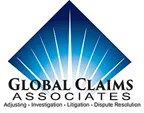Investigation of Artificial Color Infusion of Gemstones
Based on independent scientific testing Update to our report of July 24, 2019
 The general perception of crystals is that they are solid structures composed of a variety of elements bonded together to form that structure. In truth, crystals have openings of a variety of sizes and shapes that can allow outside elements to enter the crystal after formation. This can occur both naturally and artificially.
The general perception of crystals is that they are solid structures composed of a variety of elements bonded together to form that structure. In truth, crystals have openings of a variety of sizes and shapes that can allow outside elements to enter the crystal after formation. This can occur both naturally and artificially.
Below you see a graphic demonstrating the concept.

An example of coloring elements entering a gemstone naturally is Oregon Sunstone. The feldspar crystals form inside a magma chamber deep inside the earth. The rare presence of copper in the magma chamber, coupled with extreme heat and pressure, caused the copper to diffuse into the feldspar crystals forming what we now know as Oregon Sunstone.
An example of artificial coloring elements being forced into a gemstone is Tibet andesine. The Chinese company called Andegem developed a means to force copper into large feldspar crystals from Mexico, that were then sold by certain television shopping channels as natural copper-bearing feldspar known commonly as Tibet andesine without disclosure of their true nature.
The problem facing the gemstone industry is that, as demonstrated in the two examples above, it is possible to artificially create a gemstone color that emulates a natural gemstone color. The “cooker” as gemstone treaters are known, can then sell that artificially colored gemstone on the market as natural and make millions of fraudulent dollars in profits. They get away with it since the major gemology labs have proven themselves very inept at identifying these treatments before issuing certificates verifying authenticity.
Looking for “footprints.”
During the course of the investigation into the Tibet andesine fiasco, it was revealed by a famous instructor of gemstone treatments, Ted Themelis, that any gemstone can now be artificially color enhanced using the knowledge of the crystal openings and advanced technology of coloring element diffusion. It was also presented to me that virtually all of these artificial color diffusion processes would leave an identifying “footprint” if one knows where to look and what to look for.
Basically, that the treatment itself would leave an identifying trait if one knew the traits.
The Paraiba Tourmaline Investigation
 During the andesine investigation, I was approached by one of the owners of a tourmaline mine in Paraiba, Brazil. His mine produced some of the famous “Paraiba Tourmalines” that are found there, and in the neighboring state of Rio Grande de Norte, an example is seen at left. He reported that copper-bearing blue tourmalines rivaling the Paraiba Tourmaline were being sold on the market as Paraiba Tourmaline, but were reportedly being mined from Mozambique. He further stated that he had evidence that the same artificial copper diffusion process used on Tibet andesine was being used on these Mozambique sourced tourmaline.
During the andesine investigation, I was approached by one of the owners of a tourmaline mine in Paraiba, Brazil. His mine produced some of the famous “Paraiba Tourmalines” that are found there, and in the neighboring state of Rio Grande de Norte, an example is seen at left. He reported that copper-bearing blue tourmalines rivaling the Paraiba Tourmaline were being sold on the market as Paraiba Tourmaline, but were reportedly being mined from Mozambique. He further stated that he had evidence that the same artificial copper diffusion process used on Tibet andesine was being used on these Mozambique sourced tourmaline.
Based on our successful investigation of the Tibet andesine fiasco, I realized we could apply the same investigative techniques to this Paraiba Tourmaline issue and discover the truth. However, the matter was made difficult since the Lab Manual Harmonization Committee, whose membership includes the largest gemology labs in the world, had recently hijacked the name “Paraiba Tourmaline” and adopted the use of the term “Paraiba” to be used on the Mozambique material. Knowing the propensity of the world gemology labs to placate big money dealers, this created even more questions as we had just dealt with the GIA and Gem-A being players in the Tibet andesine fiasco on the side of Andegem, Jewelry Television, and Direct Shopping Network. For this reason, I relied solely on outside, independent scientific labs to perform the advanced testing.
The Investigation Reveals the Mechanics of Artificial Color Infusion
Just as with the Tibet andesine investigation, this office accumulated over 1400 tourmaline specimens from as many world sources as possible. These included parcels sent to us direct from mining operations in Nigeria, Brazil, and others. Based on the information from Ted Themelis, we knew we were looking for a footprint that would denote the artificial coloring process. The vast majority of tourmalines we inspected showed no signs of treatments. However, one group of tourmalines obtained from a variety of dealers in Bangkok, Thailand, exhibited a predictable pattern of colors and inclusions that were anomalous to all other tourmalines. These happened to be extremely intense and uniform in color and possessed unusual inclusion formations. They also included most of the tourmalines claimed to be copper-bearing from Mozambique.
 The first two specimens were rough pink and green tourmalines seen at left. These exhibited an unusual glazed red and yellow crust, much like the white crust found on andesine that contained a high content of copper. I surmised that if this was the same process, the crust of these tourmalines would contain high levels of the color elements of these two: Manganese for the pink and iron for the green. As a result, I turned to the EAG Laboratories to perform an elemental analysis of this material using Laser Ablation Inductively Coupled Mass Spectrometry (LA-ICP-MS). Below you see the results of this testing.
The first two specimens were rough pink and green tourmalines seen at left. These exhibited an unusual glazed red and yellow crust, much like the white crust found on andesine that contained a high content of copper. I surmised that if this was the same process, the crust of these tourmalines would contain high levels of the color elements of these two: Manganese for the pink and iron for the green. As a result, I turned to the EAG Laboratories to perform an elemental analysis of this material using Laser Ablation Inductively Coupled Mass Spectrometry (LA-ICP-MS). Below you see the results of this testing.
Below left is the result of the green stone with levels of iron so high that they are listed simply as “Matrix.” Below right is the result of the pink tourmaline test showing the same levels of manganese. Each of these tourmalines exhibited the same extreme levels of their coloring elements fused into their surface, but the results went one step further.
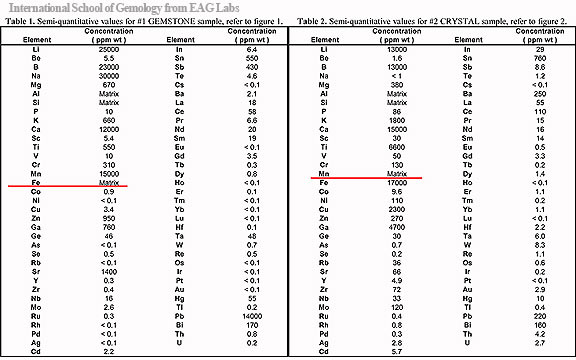
The glazed material showed what would become a diagnostic red and yellow color. Below is a magnified image of the glaze material that presented extremely high levels of the coloring elements of these gemstones.

I continued reviewing specimens claimed to be from Mozambique that presented anomalous features to known tourmaline structure. Many of these had grossly enlarged growth tubes that were filled with the same unusual red and/or yellow material. The one common denominator was that all of these tourmalines were being sourced through Bangkok, Thailand dealers.
 One very unusual tourmaline caught my attention due to the intense green color and huge growth tube that ran across the stone. The actual stone is seen at left. By Raman comparison here in our lab, I was able to determine that one end of this tube was filled with polishing compound used in the cutting and faceting of the gemstone. However, the other end was filled with a very unusual material of intense red color with yellow material being on the edges. The material was of a composition that it was hard enough to have been faceted during the cutting process. Below left is the image of the polish compound, below right is the other end of this same tube showing the red material. It was this red material deep inside this Mozambique tourmaline that we could now use to get a full elemental analysis of its content.
One very unusual tourmaline caught my attention due to the intense green color and huge growth tube that ran across the stone. The actual stone is seen at left. By Raman comparison here in our lab, I was able to determine that one end of this tube was filled with polishing compound used in the cutting and faceting of the gemstone. However, the other end was filled with a very unusual material of intense red color with yellow material being on the edges. The material was of a composition that it was hard enough to have been faceted during the cutting process. Below left is the image of the polish compound, below right is the other end of this same tube showing the red material. It was this red material deep inside this Mozambique tourmaline that we could now use to get a full elemental analysis of its content.
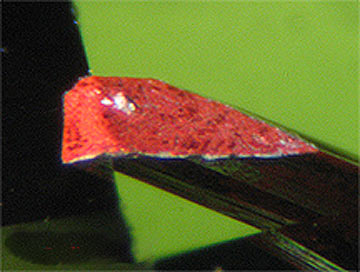

To perform this, we again turned to the EAG Laboratories, this time for XRF (X- ray fluorescence). Once again, the results were quite astounding.
Below is the XRF reading presented to us by EAG Laboratories. Note that the red lines denote the testing of the actual tourmaline, and the black lines are the red filler material inside this tube. The extremely high levels of iron in the red material deep inside this tourmaline could only have been possible by some kind of artificial infusion.
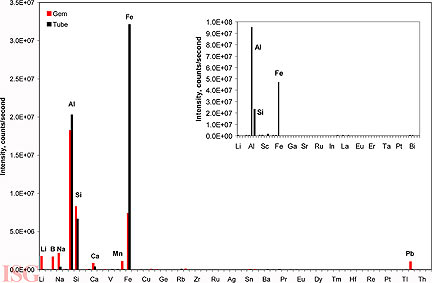
To demonstrate the overall test results, below is a graphic to demonstrate how extreme the levels of Fe and Mn are in the tourmalines we tested. This graph of the LA-ICP-MS testing of the first two tourmaline specimens demonstrates the overall numbers found in all of the specimens tested. In blue are the normal levels of various elements that compose a tourmaline. In the red and green sections are the levels of elements found by independent scientific testing in those tourmalines found to have treatment indicators. The results serve as clear evidence that something unusual is being done to these tourmalines to cause these readings.
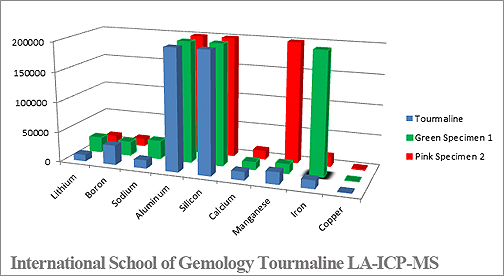
The final step in our scientific testing was based on the concept presented to me by various scientists from the independent labs I was working with. The concept: If coloring elements were being introduced into these gemstones artificially, the coloring element, along with the flux used to enhance the process should be of higher content inside the gemstone. The concept was that the coloring element would flow into the gemstone, like water flowing on a downhill slope.
It had been established that calcium was being used as a flux material with Tibet andesine, which accounted for why the Mexican feldspar gave unusual andesine readings after treatment. If this process was the same, it was reasonable to predict that a higher level of calcium and the coloring element would be found inside the gemstone. That the levels of calcium and copper, for instance, would be higher inside a treated Mozambique tourmaline than at the exterior surface. To test this, I took a blue-green, copper-bearing Mozambique tourmaline and cut it in half, and sent it to EAG Laboratories for XRF (X-ray fluorescence) testing.
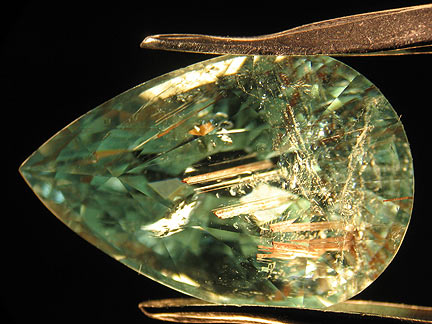
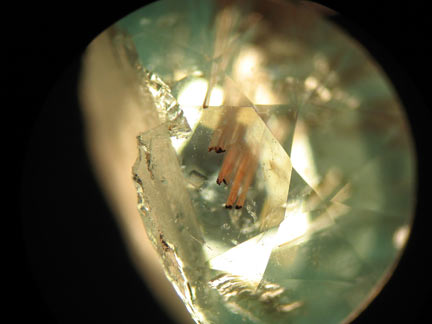
Below is the result.
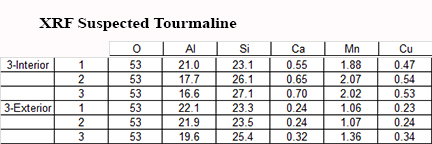
The interior copper and manganese content is 2x the amount of the exterior of the gemstone. Importantly, the calcium content inside the stone is also 2x the level of calcium on the exterior of the gemstone. Consultation with the scientists at EAG confirmed that these results could only present themselves if something artificial was being done to the gemstone. The readings inside the stone are too extreme to be explained by any natural process, given that the other readings are virtually identical.
Time for grassroots testing
Now that we had the independent scientific test results that showed something artificial was being done to the stones, it was time to find the “footprint” that Ted Themelis told us would be present. It did not take long.
Magnetism of Red Tourmalines
According to the excellent website: GemstoneMagnetism.com by Kirk Feral:
“Pink Tourmalines and red Tourmalines (“Rubellite”) are colored by manganese in the valence state of Mn3+, which generally produces lower magnetic susceptibility than what is found in gems colored by Mn2+. This is because only tiny amounts of Mn3+ are sufficient to produce bright pink and red colors. Consequently, pink and red Tourmalines are among the least magnetic Tourmalines, with responses ranging from Inert to Weak to Moderate.”
Knowing that I had red tourmalines with extremely high levels of manganese, based on independent scientific testing, I suspected that the magnetic susceptibility of these tourmalines might be altered significantly due to artificial infusion of certain types of manganese. I set up a control test of tourmalines I had owned from my days working with the Brazilian mining company, Amsterdam Sauer. Below are examples of the magnetic susceptibility of these tourmalines, confirming the report by Kirk Feral that the red tourmalines were indeed inert to weak to magnetism.
I used an industrial-grade magnet with the tourmaline hung on a string with a wire pointer and lines printed on paper to work as a graph point.
Notice that both natural red tourmalines (my control stones) hang straight down in the left-hand images, and when the magnet is pushed just to their side, they have little or no reaction. This is the reaction predicted by Kirk Feral and clearly demonstrated by these tourmalines. However, on the lower right image, when one of the suspected infusion-treated red tourmalines was hung on the wire…before I could even get the magnet close, it jumped out toward the magnet as seen at left. I had to pan out the camera shot to be able to photograph the test due to the extreme reaction.

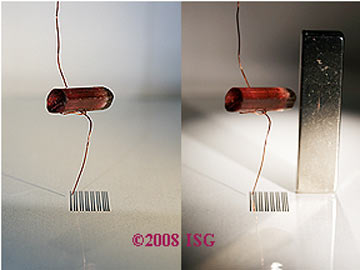
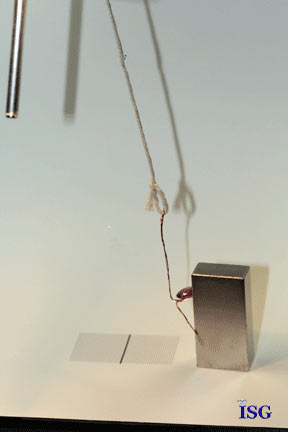
It is my conclusion that the infusion of high amounts of magnetically susceptible manganese described by Kirk Feral is the cause of this very extreme magnetic reaction of this tourmaline. Based on our control stones and the information from the Gemstone Magnetism website, magnetism clearly appears to be one of the footprints of color- infused red tourmalines.
Given the growing evidence regarding this matter, there was one more piece of evidence I needed to complete the investigation: a picture that clearly showed the treatment in process. Based on my research of Tibet andesine, I knew that finding a gemstone whose treatment had failed was what I needed to find, and it did not take long.
Below is a blue, copper-bearing tourmaline sold as Paraiba Tourmaline from Mozambique. It did not take long to find the footprint that clearly demonstrated color infusion of this tourmaline.

Below is the image that ended the search for visual confirmation of treatment. This blue tourmaline clearly shows blocked tubes that prevented the coloring material from entering the crystal. The long colorless blocked tubes are diagnostic evidence of color infusion gone bad, and clear evidence of undisclosed color infusion.

Below you see a top view of this area from the other side of the tube. The lack of coloring is due to the blocked tubes seen above. The blocked tubes prevented the color infusion material from entering the crystal, leaving the formation you see at left. Clear evidence of artificial color infusion of this tourmaline.

Conclusion
After all of this evidence that has been published by this office for the past 10 years, one would think the major gemology labs would take notice of this situation. It is also reasonable to believe that some kind of action would be taken by the Lab Manual Harmonization Committee regarding their erroneous use of the term “Paraiba Tourmaline” for tourmalines not from Paraiba, Brazil. Neither has taken place.
It has been reported that miners in Mozambique have invited guests to come to the mining area there and find the tourmaline crystals for themselves in the streams and rivers. The only problem is, the tourmalines are reported to have been brought in from the cooking ovens in Thailand and Germany and thrown into the streams and rivers to be found by these same guests. A variation of the tricks used in the hoax expedition reports to the Tibet andesine mines. Exactly what or who is the source of all this…I do not know, but the evidence points to a commonality for both cases which is collusion by the major gem labs with big money gemstone dealers.
Notwithstanding the above, the independent scientific test results clearly point to an artificial color infusion process taking place with gemstones. Add to this the statements by Ted Themelis confirming that any gemstone can be color-infused, and the anomalous magnetic response of red tourmaline, the case is made even stronger. Finally, the photographic proof of the failed effort at color infusion of the blue copper-bearing tourmaline claimed sold as Mozambique; the only possible conclusion is that artificial color of gemstones is taking place and that it is possible to find the tell-tale footprints using basic gemology test methods if one knows what to look for.
The real problem is that one day all of this will be fully exposed, and the loss of consumer confidence will be great. We are already fighting an uphill battle against fraud in the gemstone industry. Obviously, what we know is just the tip of the iceberg of what is actually happening.
Robert James FGA, GG
